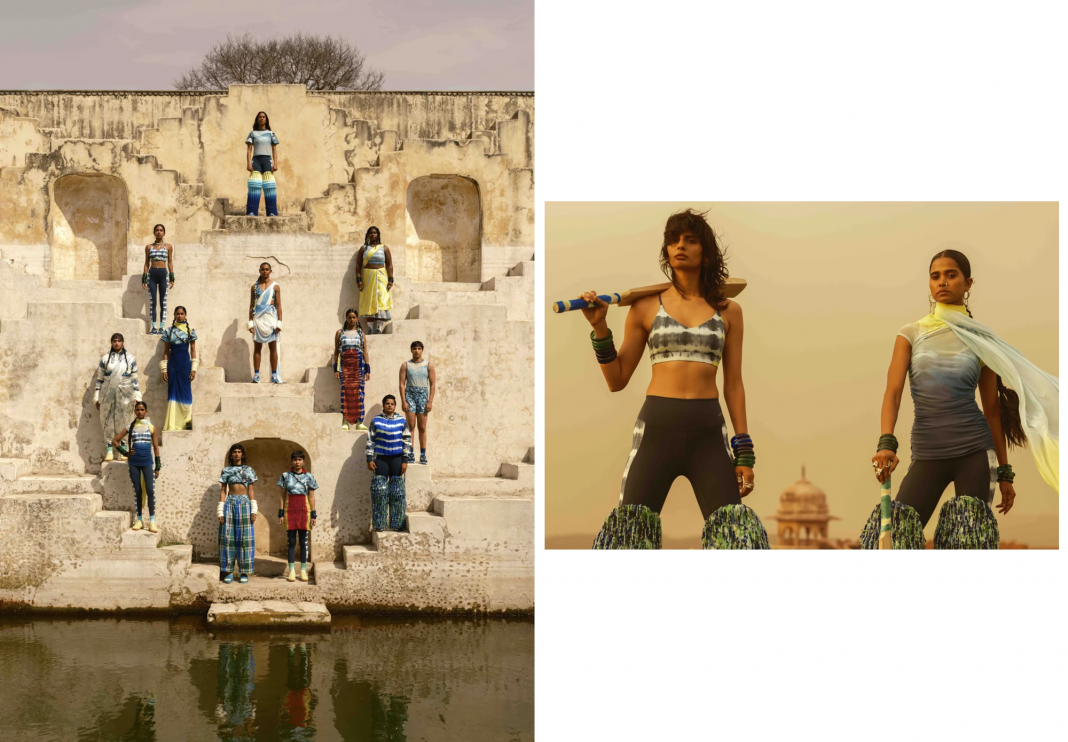Nike’s first collaboration with an Indian fashion label is more than a product drop — it’s a cultural dialogue. With vibrant patterns inspired by a 5,000-year-old tie-dyeing technique and a campaign spotlighting Indian female athletes, the collection blends craft, community, and movement into a bold vision for sport, heritage, and self-expression.
A new play for India
Nike has officially stepped into a new chapter in India with its first-ever local design collaboration — a limited-edition collection with Delhi-based fashion label NorBlack NorWhite. The release, which includes patterned sportswear and footwear, pays homage to bandhani, an ancient Indian tie-dyeing technique known for its vivid geometric motifs and spiritual symbolism.
While the drop is undeniably fashion-forward, its timing also signals Nike’s renewed ambitions in a challenging yet crucial market. After entering India through a licensing deal in 1995 and going fully owned by 2004, Nike made a major push in 2005 by becoming the official kit sponsor for the Indian national cricket team. But despite the country’s deep passion for sport, the company has struggled to maintain consistent commercial growth. From a peak of 350 stores, Nike has since reduced its footprint in India to just 93 — a sharp contrast to its more than 2,600 stores across China.
Heritage in motion
At the center of this collaboration is bandhani, a labor-intensive dyeing process that has been practiced for millennia across regions of Gujarat and Rajasthan. It involves precisely tying small portions of fabric with thread before dyeing, creating kaleidoscopic patterns that evoke movement, geometry, and cultural memory. Traditionally worn for festivals and rituals, the technique has now found new expression — on hoodies, tanks, crossbody bags, and sneakers.
NorBlack NorWhite, led by Canadian-born co-founders Mriga Kapadiya and Amrit Kumar, has long used bandhani and other regional textile traditions in its streetwear-inflected collections. “This collection shines a light on the rigor, dedication and ancestral knowledge that’s rooted in Indian culture,” Kapadiya said via Nike’s website. “And we hope each piece inspires women to draw into their own athletic mindset while navigating everyday life in India and around the world.”
That ethos is evident in the collection’s wearable silhouettes and athletic focus. Sports bras, oversized tees, and Air Max sneakers feature abstracted bandhani motifs — not as nostalgic decoration, but as kinetic patterns echoing the rhythm of movement. The designs feel more like tools of empowerment than trend-chasing apparel. They say: you belong here — on the court, the field, the street.
Women, redefined
The collaboration also aligns with Nike’s growing emphasis on women in sport, an area the brand has recently prioritized after decades of male-dominated marketing. At this year’s Super Bowl, Nike’s spotlight fell on WNBA star Caitlin Clark and Olympic sprinter Sha’Carri Richardson — a clear signal of shifting focus. In India, that same attention is now being extended to a new generation of women athletes whose presence on the global stage is growing.
By featuring female athletes not just in performance settings but in campaign storytelling — styled and shot with fashion’s aesthetic sensibilities — Nike positions athleticism as a full-spectrum identity. It’s not just about medals or minutes played. It’s about resilience, routine, grace, and grit. And, importantly, it’s about representation — the kind that transcends statistics and speaks directly to culture.
The Jaipur backdrop deepens this intention. The ornate architecture, once symbols of royal grandeur, now frame athletes whose power comes not from lineage but from self-made determination. Through this lens, sport is no longer a Western export but something innately rooted in Indian lives — and bodies.
More than just a launch
For NorBlack NorWhite, the collaboration is a milestone in a longer journey of platforming India’s textile traditions in contemporary contexts. Since its founding in 2010, the brand has consistently explored the intersection of heritage and hype, reimagining saris, turbans, and dyeing techniques through the lens of modern design. Partnering with Nike elevates that mission onto a global platform.
For Nike, it’s a test — and a statement. After decades of viewing India primarily through a cricket-shaped lens, the brand appears to be widening its scope. This is not just a nod to history; it’s a recalibration. India’s fashion-literate, digitally native youth aren’t looking for generic athleticwear. They’re looking for identity, resonance, and pride. And collaborations like this, when done right, offer just that.
It’s too early to say whether this partnership will reshape Nike’s fortunes in India. But what it does show is that when a global brand listens, learns, and collaborates with care, the result can be more than a product — it can be a platform.





